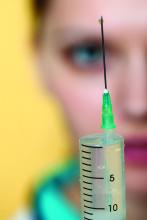A two-dose schedule of the 9-valent human papillomavirus (HPV) vaccine in children aged 9-14 years is noninferior to a three-dose schedule in adolescent girls and women (aged 16-26 years), based on immunogenicity measurements.
Many countries have poor HPV vaccination rates, in part because the current regimen requires three doses over a 6-month span, and it can be challenging in some areas for children to make three health care visits in the required time span. “Using an effective two-dose regimen entailing fewer visits could improve adherence to HPV vaccination programs. Coadministration of the 9-valent HPV vaccine with diphtheria, tetanus, pertussis, polio, and meningococcal vaccines could also be completed at the same visit,” reported Ole-Erik Iversen, MD, PhD, of the University of Bergen (Norway) and his colleagues (JAMA. 2016 Nov 21. doi: 10.1001/jama.2016.17615).
For this study, which was conducted at 52 ambulatory care sites in 15 countries, the researchers analyzed data from 1,377 participants separated into five groups: girls aged 9-14 years who received two doses in a 6-month interval (n = 274); boys aged 9-14 years who received two doses in a 6-month interval (n = 273); girls and boys aged 9-14 years who received two doses at a 12-month interval (n = 269); girls aged 9-14 years who received three doses over a 6-month interval (n = 275); and a control group of girls and women aged 16-26 years who received 3 doses over a 6-month interval (n = 286).The researchers measured serum anti-HPV antibodies 1 month after the final dose. At least 98% of the participants in each group seroconverted to a response against all 9 HPV subtypes, and analysis of the antibody geometric mean titers revealed that the groups who received two doses had noninferior responses to the control group of adolescent girls and young women who received three doses.
Antibody geometric mean titers against all 9 HPV types were higher in subgroups of boys and girls (aged 9-10 years, aged 11-12 years, and aged 13-14 years) who received two doses, compared with girls and young women who received three doses. “These observations suggest that the overall results of the primary immunogenicity analyses may be applicable across the entire studied age range of girls and boys,” Dr. Iversen and his associates wrote.
The study cannot prove that the two-dose regimen has equal efficacy to the three-dose regimen in preventing HPV infection, only that the immunogenicity is noninferior, they said.
The study was sponsored by Merck, which manufactures the vaccine. Study authors have financial ties to Merck and a number of other pharmaceutical companies.


